|
 U.S. Capitol Building, Washington, D.C. Posted by:  JimmyEv JimmyEv
N 38° 53.388 W 077° 00.617
18S E 325648 N 4306468
“I’m just a bill...And I’m sitting here on Capitol Hill...” If you were a kid in the 1970s those lyrics might play in your head as you gaze up the endless steps to the Capitol Building. Almost as many steps as that poor bill had to go through.
Waymark Code: WM2FCY
Location: District of Columbia, United States
Date Posted: 10/24/2007
Views: 368
|
The massive building on the slight hill at the end of The Mall - that’s the Capitol Building. The south wing (facing the building, the wing on the right) houses the U.S. House of Representatives; the north wing (to the left) houses the U.S. Senate. You can see the short domes of the original House and Senate chambers, barely protruding beyond the roof between the dome and each of the new wings.
There are two ways to tour the building: on a public tour, or a staff tour. It is well worth contacting your Congressperson to get a staff tour scheduled. If you’re stuck with the public tour, like I was, your first stop has to be the Capitol Visitors Center’s temporary headquarters - a small trailer on the grounds near the U.S. Botanic Gardens. This is where you get your ticket for the tour of the Capitol. Work is progressing on the center’s permanent headquarters, a massive underground complex.
|
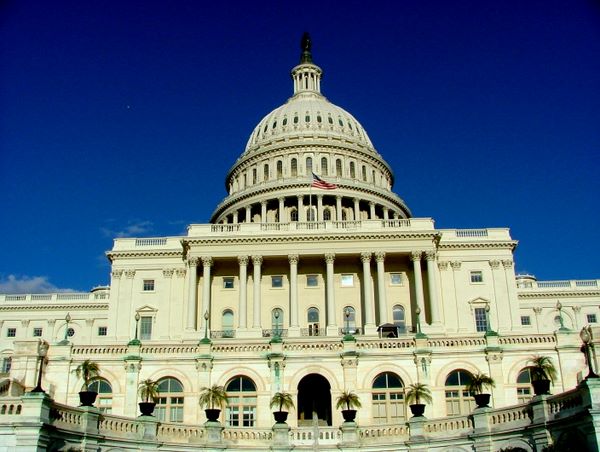
|
|
Get there early. It opens at 9am. Arriving at 9:30am, the Tuesday following Labor Day, there wasn’t a line but there was still a 45 minute wait for the tour. The wait gives you time to wander around the west terraces of the building and check out the guys with the sub-machine guns on the Capitol steps (you might have the slight feeling that you’re in El Salvador), as well as the views extending down the The Mall and Pennsylvania Avenue. |
|
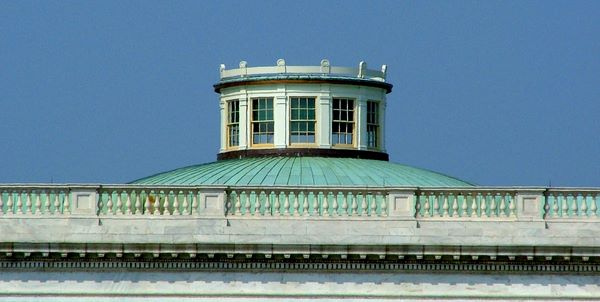 |
Be sure to get back down to the Visitors Center at the time printed on your ticket; if you’re late, you have to get another ticket. The guide takes you back up the hill, where you go through security (the security guys are nicer here than the ones at the Smithsonians). The docent leads you across the upper terraces, with their awesome views, and into the mammoth building. First on the agenda is a lecture. Since 9/11, you must stay in an imaginary semi-circle in front of the docent. Otherwise you might be ‘subject to embarrassment.’ Do not dwadle. Do not wander away to look at something. The semi-circle must be tight. Not a problem, you think.
|
|
Then you get to the Rotunda. It’s huge. It’s magnificent. It’s beautiful. The detail is simply tremendous. Overwhelming, to say the least. You want to soak it all in. But you have to listen to the docent, droning along in her Southern patter, getting angry when the visitors don’t participate readily in her Socratic discussion about American history. You want to look at that painting and that painting, and whose bust is that over there? But you are confined to the semi-circle. You see others freely roaming around, drifting along with their escort, leading their escort around from one interesting item to another, peppering him with questions. Those are the people on the staff tours. And you’re stuck being asked questions like ‘What’s the minimum number of Representatives in the House from a state?’ by the retired school teacher. |
|
Then she mentions the fresco in the eye of the Rotunda, The Apotheosis of Washington, 180 feet above the floor. All eyes turn upwards. It took Italian artist Constantino Brumidi 11 months to paint this fresco in 1865. The painting depicts George Washington rising into heaven, flanked by thirteen maidens symbolizing the original thirteen states. It is basically the Assumption of George Washington. Realizing that you had never known George Washington was so deified, the Rotunda becomes just a tad bit disturbing.
But then your attention drifts to the other items in the 96-foot diameter circle. Eight huge, framed paintings depict early American history - the Declaration of Independence, the Surrender of General Burgoyne, the Surrender of Lord Cornwallis, General George Washington resigning his commission, the landing of Columbus, the discovery of the Mississippi, the baptism of Pocahontas, and the embarkation of the Pilgrims. Relief panels depict more scenes of early American history - the conflict of Daniel Boone and the Indians, the landing of the Pilgrims, the saving of Captain Smith by Pocahontas and William Penn’s treaty with the Indians. Scattered around are busts of John Cabot, George Washington, Christopher Columbus, Sir Walter Raleigh, Sieur de La Salle, and statues of George Washington, Abraham Lincoln, James Garfield, Andrew Jackson, Thomas Jefferson, Alexander Hamilton, the Marquis de Lafayette, Dr. Martin Luther King, Jr., and Ulysses Grant.
Looking back up into the dome, you can see Brumidi’s other work, a frieze began in 1877 lining the diameter of the dome. Brumidi died during the time he was painting these almost three-dimensional scenes of American history. The work was continued by artist Filippo Costaggini following Brumidi’s sketches. The history of America was traced from its discovery by Columbus to the discovery of gold in California. Costaggini left a 31-foot gap in the diameter of the frieze. The gap allowed artist Allyn Cox to update American history in 1953, by filling out the frieze with scenes of the Civil War, the Spanish American War, and the birth of Aviation.
|
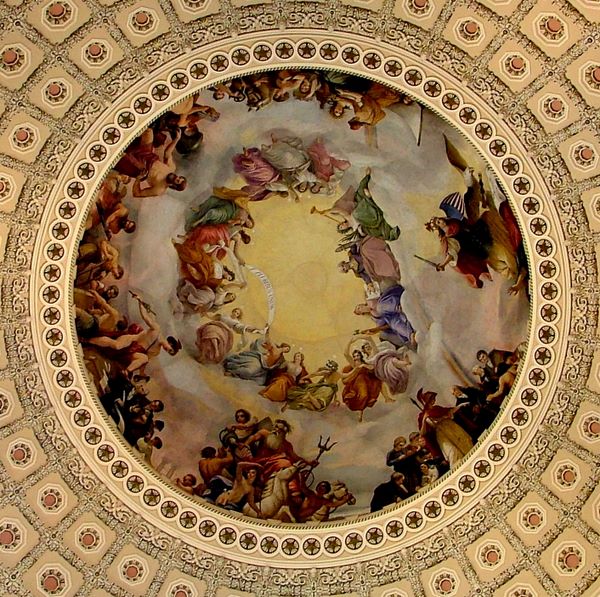

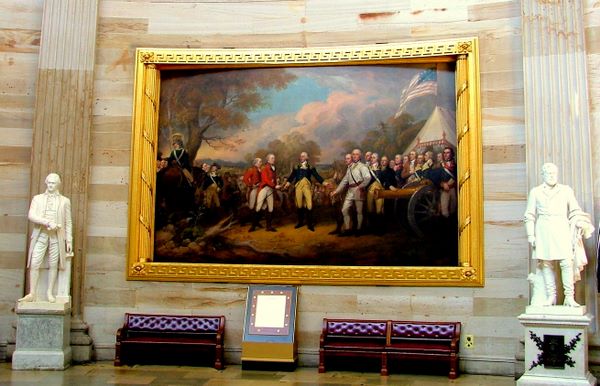
|
|
After a wholly inadequate amount of time in the Rotunda, and perhaps loosing a few non-English speaking members of the group that didn’t quite grasp the importance of the instructions, it’s on to Statuary Hall, which was once the chamber for the House of Representatives. Beginning in 1864, each state was invited to donate two statues of their most prominent citizens to the Capitol. Most of the statues fit inside Statuary Hall, but a few have been moved to other portions of the Capitol that you won’t see on this tour. House members never liked using this room as their chamber; it suffers from very bad acoustics. The docent will demonstrate how whispers in one portion of the chamber can be heard clearly in another distinct portion of the chamber by having you stand in one spot while she whispers into the floor about 25 feet away. This is one part of the tour that hasn’t changed since 1980. |
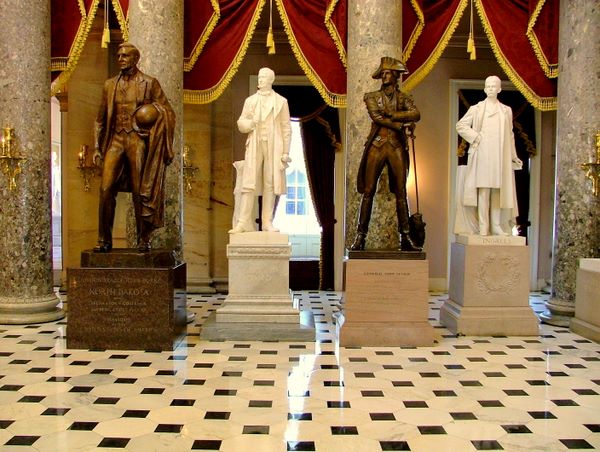 |
Somehow the docent will wind you from the former House chamber to the former Senate chamber without going through the Rotunda again. I think this is designed to disorient you. The Old Senate Chamber was restored to its original appearance in 1976. You can see a portrait of George Washington by Rembrandt Peale and the former desk of the Vice President. This is where the Missouri Compromise of 1820 was hammered out, where the fiery rhetoric of Henry Clay and John Calhoun was heard, and where the nullification debates took place. The chamber was taken over by the Supreme Court in 1860 when the Senate moved to its new wing. The court stayed here until 1933, when the third branch of American government finally got its own building.
|
|
From here it’s down to the Crypt, below the Rotunda. Along the way you’ll pass some interesting things, including some extremely massive and beautifully detailed doors. But you can’t stop. Remember the tight semi-circle. |
|
The crypt is the ‘crypt’ because it was designed to house George Washington’s crypt. The room was built. Washington’s heirs refused to allow the body to be moved from Mount Vernon. So it remains an empty crypt. In the crypt the docent gives you directions to the exit and disappears. The room is filled with displays about the Capitol Building, its design and its construction. There is a small gift shop, to get that perfect gift to remember your rushed tour. Off of the crypt is the Old Supreme Court Chamber. A sign says you can’t enter without a docent, but she disappeared, so ignore it.
This chamber was used by the Supreme Court from 1819 until 1860, when it moved upstairs. The room was restored to near its original appearance in 1975 for the Bicentennial celebration. The ceiling of the chamber is interesting; it looks like it’s baffled. Everything else about the room is dark (probably because the windows were covered up when they enlarged the building). It looks like a courtroom and exudes history. This is where the early powers of the Congress and the Presidency were hammered out, and where slavery was declared constitutional. |
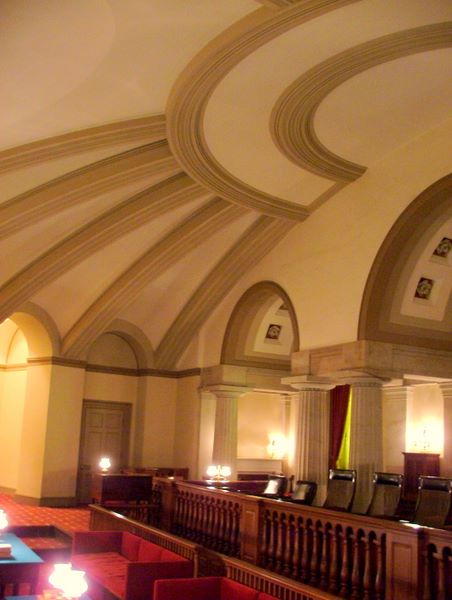
|
Portions of the Capitol you’ve missed if you didn’t pre-arrange for a staff tour (it only takes an e-mail):
- The Hall of Columns, a 100 foot expanse with 28 fluted columns of Massachusetts marble and the remainder of the statues donated by the states.
- The Minton Tiles, the hand-painted flooring of the hallways lining the Senate and House wings.
- More work from Italian artist Brumidi - colorful murals painted on every square inch of the hallways in the Senate wing.
- Getting to see in person what you can only glimpse on C-Span, the House and Senate in action.
And the staff tours start in one of the House or Senate Office Buildings, so you get to ride the Capitol’s exclusive subway. Don’t forget the added bonus of being able to see the inside of some of these office buildings on the staff tours, in particular the Russell and Hart Senate Buildings. |
The "Official Tourism" URL link to the attraction: [Web Link]

The attraction’s own URL: [Web Link]

Hours of Operation:
Monday-Saturday, 9am-4:30pm

Admission Prices:
Free.

Approximate amount of time needed to fully experience the attraction: Half of a day (2-5 hours)

Transportation options to the attraction: Personal Vehicle or Public Transportation

|
Visit Instructions:As a suggestion for your visit log, please make every effort to supply a brief-to-detailed note about your experience at the Waymark. If possible also include an image that was taken when you visited the Waymark. Images can be of yourself, a personal Waymarking signature item or just one of general interest that would be of value to others. Sharing your experience helps promote Waymarking and provides a dynamic history of your adventures.
|